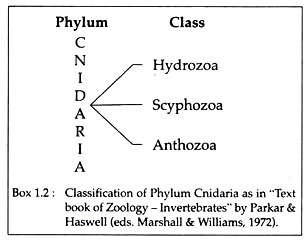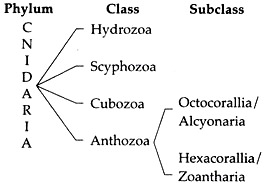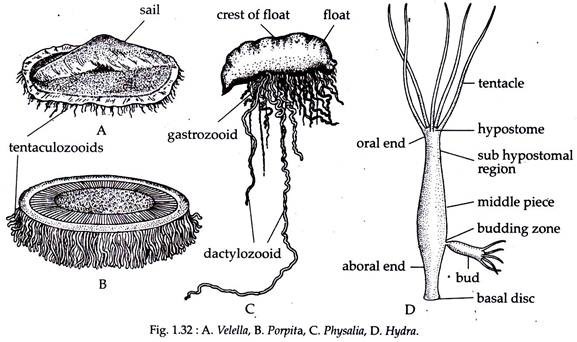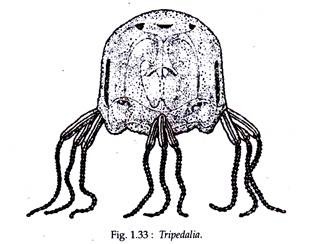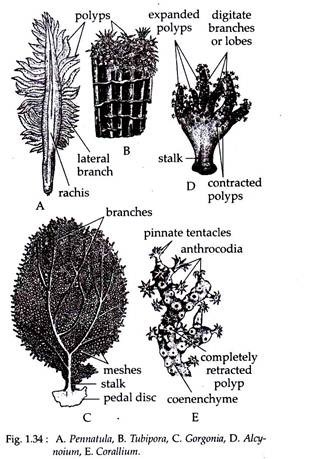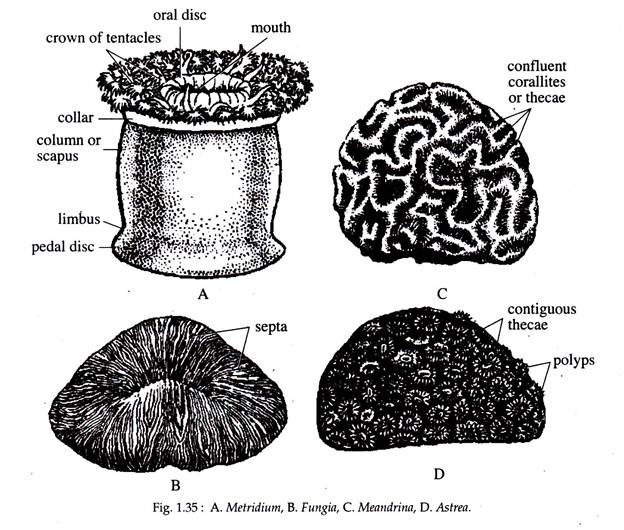In this article we will discuss about the Phylum Cnidaria:- 1. Classification of Phylum Cnidaria 2. Diagnostic Features of Phylum Cnidaria 3. Scheme of Classification 4. Systematic Resume.
Classification of Phylum Cnidaria:
The phylum Cnidaria is a diverse group with cosmopolitan distribution. It includes the familiar hydras, the transparent jelly fishes, the beautiful and bright coloured sea anemones, a variety of corals and about 10,000 delightful aquatic species.
The phylum Coelentarata was established by Leuckart in 1847, which also included the sponges and ctenophores. In 1888, Hatschek splitted Leuckart’s Coelenterata into 3 distinct phylum: Spongiaria (Porifera), Cnidaria and Coelenterata.
The cnidarians are almost all marine and are either sessile or free-swimming and occur singly or in colonies. They are characterised by the possession of radial symmetry (a primitive feature), two layers of cells, gut cavity lined by endoderm, vibratile tentacles arranged in one or more whorls around the mouth and provided with nematocysts (the stinging organ). They are the pioneer in the tissue grade of organisation.
ADVERTISEMENTS:
Etymology:
Cnidaria—Greek: knide, nettle
Diagnostic Features of Phylum Cnidaria:
i. All the members are aquatic and with the exemption of a few, are marine.
ii. Body diploblastic i.e. composed of two tissue layers, an outer epidermis (ectoderm) and an inner gastro-dermis (endoderm) with several to many cell types and a less cellular mesoglea at the centre.
ADVERTISEMENTS:
iii. Two different body forms may exist—a ‘medusa’ (representing sexual phase) adapted for pelagic existence and a ‘polyp’ (asexual phase) adapted for benthic existence.
iv. They exhibit radial symmetry.
v. Head and body segmentation absent.
vi. Short and slender tentacles encircle the mouth in one or more whorls.
ADVERTISEMENTS:
vii. In the body there is an internal space for digestion, the ‘gastro-vascular cavity’, with the mouth as the only opening.
viii. They thrive on both intracellular and extracellular type of digestion.
ix. The body wall composed of a special type of cell called of ‘Cnidocytes’, containing stinging organelles called ‘nematocysts’.
x. They are acoelomates due to the absence of coelom.
xi. Respiratory, circulatory and excretory systems are absent; gas exchange is performed by diffusion.
xii. Nervous system is of primitive type consisting of diffused network of un-polarized nerve cells.
xiii. Reproduction is both asexual by budding and sexual by ova and sperm. Development often involves an almost bilaterally symmetrical, ciliated ‘planula’ larva.
xiv. Life history commonly illustrates the phenomena of metagenesis.
Scheme of Classification of Phylum Cnidaria:
The classification of Cnidarians by Parker and Haswell or as revised by Marshall and Williams, 1972 (7th edn.), is very much similar to that of Ruppert and Barnes (1994), except that the later authors have introduced an additional class-Cubozoa, for the medusoid cnidarians with bells.
The classificatory scheme followed in this text is based on the scheme outlined by Ruppert and Barnes, 1994 (6th Edn.)
Systematic Resume:
Class Hydrozoa (Greek: hydro, water serpent):
i. Individuals are either exclusively polyploid or medusoid or constituted by both forms in the life cycle.
ii. Mesoglea acellular.
iii. Cnidocytes are confined to the epidermal layer.
iv. Coelenteron is undivided and without stomodaeum.
v. Gonads are usually ectodermal in origin or if endodermal, gametes do not escape through the coelenteron and mouth.
Examples:
Hydra (Fig. 1.32D), Obelia, Millepora, Physalia (Fig. 1.32C), Valella (Fig. 1.32A), Porpita{Fig. 1.32B).
Class Scyphozoa (Greek: skyphos, cup):
i. Medusoid form is dominant in the life cycle; polypoid form is very insignificant.
ii. Mesoglea is cellular.
iii. Some cnidocytes are endodermal.
iv. The endodermal gastric tentacles are present.
v. Velum is absent.
vi. Gonads are endodermal.
Example:
Aurelia (Fig. 1.38), Pilema, Lucernaria, Pericolpa.
Class Cubozoa (Greek: Cubo, cube)
i. Medusoid cnidarians with bells.
ii. Body is distinctly flattened to form four sides.
iii. Bell margin simple.
iv. Presence of velum along the margin of the medusa.
v. There are four tentacles or tentacle clusters at the four corners of the margin.
vi. Body wall possess a type of nematocyst called stenotale.
Examples:
Carybdea, Chiropsalmus, Chironex, Tripedalia (Fig. 1.33).
Class Anthozoa (Greek: Anthos, flower):
i. Exist only in the polypoid form.
ii. Mesoglea cellular.
iii. Some cnidocytes are endodermal.
iv. Stomodaeum strongly developed.
v. Extending between the stomodaeum and the body-wall there are mesenteries.
vi. Gonads are endodermal.
vii. Members are exclusively marine.
Subclass Octocorallia/Alcyonaria:
i. Polyp with eight tentacles and eight septa (mesenteries).
ii. Mesenteries are complete.
iii. Tentacles are pinnately branched.
iv. Only one ventral siphonoglyph is present.
v. Almost entirely colonial, usually connected by coenenchyme.
Examples:
Gorgonia (sea fan) (Fig. 1.34C), Pennatula (Sea-pen) (Fig. 1.34A), Alcyonium (Dead-men’s finger) (Fig. 1.34D), Helipora, Telesto, Tubipora (organ-pipe coral) (Fig. 1.34B), Corallium (red coral) (Fig. 1.34E).
Subclass Hexacorallia / Zoantharia:
i. Polyps with more than eight tentacles and septa, typically in cycles of 12.
ii. Tentacles are hollow and un-branched.
iii. Usually two siphonoglyphs are present.
iv. Solitary or colonial.
Examples: Sea-anemones (Adamsia, Edivardsia, Metridium) (Fig. 1.35A), Fungia (mushroom coral) (Fig. 1.35B), Astrea (star coral) (Fig. 1.35D), Antipathes, Meandrina (brain coral) (Fig. 1.35C).
